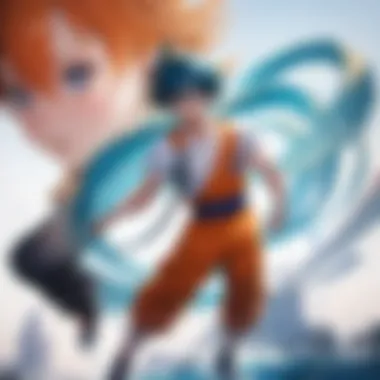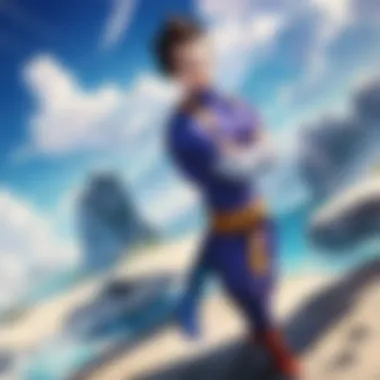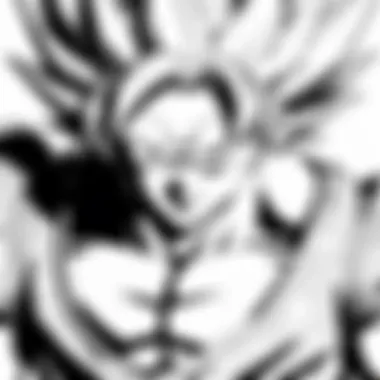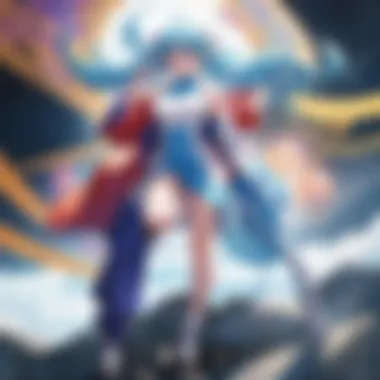Exploring the New Dragon Ball Super Manga: An In-Depth Analysis


Intro
The world of Dragon Ball Super continues to expand with its latest manga chapters. The recent storyline brings fresh narratives and character development that captivates both loyal fans and newcomers. As these new stories unfold, they invite deeper exploration of themes, artistic styles, and fan interactions. This comprehensive analysis aims to dissect these elements, providing insights into the evolution of the series.
In this article, we will discuss various aspects of the new installments, highlighting the importance of changes in character arcs and the overall narrative. We aim to connect the past with the present, ensuring readers grasp how the new content influences the broader Dragon Ball franchise. Following this introduction, several sections will analyze recent chapters, character spotlights, comparisons with the anime adaptation, industry updates, and more.
By engaging with this content, you will gain a richer understanding of the Dragon Ball universe and its characters, inviting you to consider not just the action but the intricate layers of storytelling that have kept audiences engaged for years.
Overview of Dragon Ball Super Manga
Understanding the Dragon Ball Super manga is essential for anyone interested in the anime and manga landscape. This overview serves as a foundation for discussing varying themes, character developments, and narrative progressions presented in the series. The cultural significance of Dragon Ball cannot be understated; it has greatly shaped the genre over the years.
As we delve into the complexities of this installment, several specific elements will come to light. The historical context, current status of the series, and its impact on pop culture are crucial points of discussion. Additionally, it offers readers insights into how the narrative has evolved and how it continues to resonate with audiences old and new. Given the depth and richness of the Dragon Ball universe, a comprehensive analysis will enhance the understanding of both seasoned fans and those new to the series.
Historical Context
The Dragon Ball franchise originated with the manga created by Akira Toriyama, which first appeared in 1984. It quickly gained widespread popularity and paved the way for numerous adaptations, including anime series, films, and merchandise. The storyline centers around martial arts, adventure, and a diverse range of characters. Following the main story arc, Dragon Ball Super was introduced as a sequel, exploring events that take place after the defeat of Majin Buu.
Inclusion of new gods, world-building expansions, and multiverse concepts reflect the shifting landscape of manga storytelling. These innovations helped in keeping the series relevant, attracting a new generation while still engaging long-time followers.
Current Status of the Series
As of now, the Dragon Ball Super manga is ongoing, continuing to release new chapters that captivate its audience. The current storyline has brought back familiar faces and introduced new locales along with exciting characters, each contributing to an intricate plot that promises to enthrall fans. Issues blend combat with emotional growth, portraying characters in multidimensional ways.
Dragon Ball Super has consistently remained at the forefront of manga discussions, evidenced by fan interactions across platforms like reddit and facebook. The series has adapted to cultural shifts, ensuring that its narrative feels fresh and relevant. Each chapter often leaves readers in eager anticipation, contributing to a vibrant community of enthusiasts who engage with its themes and speculate about potential directions.
Key Characters in the New Manga
Understanding the key characters in the new Dragon Ball Super manga is essential, as they drive the narrative and engage fans. This section covers prominent personalities and their roles, ensuring readers appreciate character complexities and evolutions.
Goku's Role and Development
Goku continues to be the central figure in the Dragon Ball series. His spiritual growth and commitment to becoming stronger are evident. In recent chapters, he faces numerous challenges that not only test his physical abilities but also his moral compass. Goku’s character development is composed of learning from defeats and valuing his friends.
Goku’s introduction to new techniques like the Ultra Instinct has pushed the boundaries of his character. This advanced form offers him the ability to react without thinking.
- Key Developments:
- Goku’s training under Whis enhances his fighting skills.
- His relationships with other characters, such as Vegeta, provide depth to his narrative.
These elements equip Goku with a enriched backstory, catering to both old fans and new readers.
Vegeta's Evolution
Vegeta's character arc is one of the most compelling stories in the series. Initially the villain, he has gradually transformed into a hero. His evolution is marked by dedication to protecting Earth and a desire to surpass Goku. In the new manga, his rivalry with Goku takes a more collaborative angle.
Notably, Vegeta embraces new powers and techniques. This evolution reflects his ongoing internal struggle to accept his past while constantly striving for improvement.
- Significant Points of Interest:
- Vegeta’s newfound ability to tap into the powers of the Gods.
- His emotional growth, particularly regarding family ties and friendship.


This transformation not only adds layers to his character but also enriches the overall storyline.
New Characters Introduced
The recent chapters introduce several new characters, making the narrative more dynamic. Each character plays a vital role in the unfolding drama, contributing unique attributes and challenges. They help to advance story arcs while presenting fresh conflicts and alliances.
New characters have varying backgrounds and motivations, which creates engaging interactions with established characters like Goku and Vegeta.
- A few notable characters include:
- Granolah: A bounty hunter seeking revenge. His unique goals offer much potential for conflict.
- Angel: Introduced as a mentor figure, provides guidance to younger fighters and presents new combat techniques.
The inclusion of these new personalities offers opportunities for character exploration, enriching the narrative tapestry of the series and appealing to its diverse audience.
"Character development is essential. Each new element brings an opportunity for deeper storytelling and richer experiences for the readers."
As fans explore these characters, they discover more layers to their motivations and relationships, enhancing their engagement with the manga.
Plot Analysis of Recent Chapters
In recent iterations of the Dragon Ball Super manga, plot analysis serves as an essential tool for appreciating the depth and nuance of the storyline. Each chapter contributes to a larger narrative tapestry, revealing character motivations and thematic undertones that enrich the overall experience for readers. Analyzing the plot allows fans to grasp the significance of developments and understand how they connect with the established lore. This section will delve into crucial chapter highlights, confrontations that shape character arcs, and thematic explorations that resonate with both new and returning fans.
Summary of Key Events
Recent chapters have introduced various pivotal moments that have shifted the narrative direction. For instance, in the latest saga, Goku and Vegeta confront a new adversary whose powers challenge the very fabric of their fighting capabilities. This setup not only raises the stakes but also invites contemplation of Goku's growth as both a fighter and a tactician. Key events often emphasize the importance of teamwork; the characters must collaborate and combine their unique abilities to overcome this formidable foe.
- Character Growth: Throughout these chapters, Goku's and Vegeta's interactions highlight their contrasting styles and approaches to combat.
- Unexpected Twists: Storylines have included surprising alliances, showcasing character depth beyond mere combat prowess.
The intricate plotting encourages readers to think critically about characters' decisions, laying the groundwork for rich discussions among fans.
Significant Battles and Conflicts
Battles in Dragon Ball Super have always been a core element, and the new chapters elevate this aspect to unprecedented levels. Instead of sheer power showcases, recent conflicts focus on strategy and emotional stakes, creating multidimensional clashes. For example, during one battle, Goku has to rely on his learned experience rather than brute strength to break through his opponent’s defenses.
Each significant battle can be broken down into several key components:
- Strategic Moves: Emphasis on battle tactics that reflect character development.
- Impactful Outcomes: Illustrating how victories or defeats influence subsequent character journeys.
- Emotional Layers: Conflicts are often tied to deeper personal stakes, affecting characters outside the combat arena.
These elements not only enhance the action but also ensure that battles resonate on a personal level, enriching the viewer's emotional investment.
Thematic Elements
Thematically, the current chapters explore concepts of growth, resilience, and the fine line between evil and good. There are recurring motifs of sacrifice that challenge typical hero narratives. Characters confront dilemmas that test their morals, highlighting a departure from the black-and-white morality of earlier arcs. The themes resonate deeply within the context of the series, prompting analysis of how they mirror contemporary issues outside the manga world.
Notable thematic points include:
- Growth through Struggle: Characters often evolve by facing their limitations head-on.
- Shades of Morality: The new villain's background invites discussions around redemption and purpose.
- Legacy and Succession: The actions in recent chapters hint at a narrative focused on passing the torch to newer generations.
In summary, the analysis of plot developments in Dragon Ball Super's recent chapters provides significant insight into character motivations, battles, and overarching themes. Thus, preparing fans for what to expect as the saga unfolds.
Artistic Style and Presentation


Understanding the artistic style and presentation of the Dragon Ball Super manga is crucial for appreciating its narrative depth and visual appeal. The artistic elements play a significant role in enhancing storytelling, character development, and overall engagement with the audience. As the manga evolves, its artistry serves as both a reflection of its themes and an evolution of the aesthetic that fans have come to love.
Comparison with Previous Installments
In comparing the artistic style of Dragon Ball Super with its predecessors, noticeable shifts can be observed. The earlier works of Akira Toriyama had a more simplistic and less defined line work, while the newer chapters exhibit a refinement of detail. The dynamic action sequences are now more fluid, often with intricate backgrounds that draw the reader into the scene.
Moreover, character expressions have become more varied. This enhancement allows readers to connect emotionally with characters during critical moments, which strengthens the storyline. Fans often compare panels from different arcs to illustrate these changes. Most would agree that the current art has more depth, making each page a visual experience in itself.
Character Design Changes
Character design in Dragon Ball Super showcases an evolution that aligns with the themes of growth and transformation that permeate the series. Significant characters such as Goku and Vegeta reveal more maturity in their looks, as they embody their journeys. New characters introduced in recent chapters often have more elaborate designs, reflecting unique traits and backstories.
For instance, the introduction of Granolah brings a fresh aesthetic that distinguishes him from other characters. His sharp features and unique clothing serve not only to mark his individuality but also to symbolize the complexities of his character arc. The focus on distinct styles makes it easier for readers to identify each character, enriching the overall narrative experience.
Use of Color and Paneling
Color usage in Dragon Ball Super has experienced a transformation that enhances the story’s mood and tone. The palette is often brighter and more vivid, reflecting the high stakes and excitement of battles. Key battles are accentuated with contrasting colors that emphasize the energy and dynamism of the scenes.
In terms of paneling, the layout allows for a seamless flow of action. The strategic placement of panels often heightens tension during confrontations, drawing readers immediately into intense moments. Varying panel sizes and forms also help to convey the pace of the narrative; larger panels allow for dramatic reveals while smaller ones maintain a rapid tempo during fight sequences. This thoughtful approach to both color and paneling enriches the reader's engagement and overall experience.
"Art is not just a visual enhancement; it is integral to the storytelling of Dragon Ball Super, connecting readers to characters and events on a deeper level."
In summary, the artistic style and presentation of Dragon Ball Super not only reflect its evolution over time but also serve to engage and enhance the narrative experience. The thoughtful design changes, improved color use, and innovative paneling all contribute to a richer, more immersive reading experience.
Fan Reactions and Community Discussions
The dynamic landscape of fan reactions and community discussions has become a crucial component in understanding the multifaceted impact of the Dragon Ball Super manga. This section aims to highlight how fan feedback not only influences the content itself but also contributes significantly to the culture surrounding the series. Engaged fans often share their thoughts and analyses, creating a rich tapestry of discourse that can affect how the narrative evolves.
Online Forums and Social Media Feedback
Online platforms, such as Reddit and various specialized forums, serve as central hubs for fan engagement, where discussions about the latest chapters flourish. Fans often dissect plotlines, character arcs, and thematic elements, positing their interpretations and reactions to the series. This feedback can be classified into numerous categories, from constructive criticism to enthusiastic support.
Key Features of Online Feedback
- Diverse Opinions: Fans from all over the world contribute their insights. This diversity enriches the discussion,
- Real-Time Reactions: As new chapters are released, feedback pours in almost instantly. This immediacy allows creators to gauge the audience's pulse.
- Constructive Criticism: Many fans thoughtfully critique story pacing or character motivations, helping to hold creators accountable.
The examination of these platforms reveals trends that might not be apparent from traditional reviews. Social media, particularly platforms like Facebook and Twitter, amplify these discussions, allowing for rapid dissemination of opinions.
The Role of Fan Theories
Fan theories represent another layer of community engagement. These theories often spark interesting conversations that push the boundaries of the existing narrative. Fans formulate hypotheses based on clues within the manga, creating an interactive experience that keeps the engagement high.
Aspects of Fan Theories
- In-depth Analysis: Many fans deep-dive into subtext, examining art and writing styles, which contribute to a more nuanced understanding of the manga.
- Creative Participation: Fans often develop theories that involve future character arcs or plot twists. This not only shows their investment but also highlights their creativity.
- Shared Understanding: Theories often lead to broader discussions, serving to crystallize communal sentiments regarding characters and events.
"Fan theories not only diversify the conversation surrounding Dragon Ball Super, but they also foster a sense of community among enthusiasts, connecting various interpretations and enhancing the overall experience of the series."
Through both online feedback and the construction of fan theories, the community actively shapes the narrative. This interaction signifies that the Dragon Ball franchise transcends mere consumption; it becomes a collaborative effort, where fans are essential contributors to its ongoing legacy.
Future Prospects of Dragon Ball Super


The future prospects of Dragon Ball Super are pivotal to understanding its evolving narrative and character development. With each new chapter, readers anticipate not only the exacerbation of conflicts but also the introduction of fresh story arcs that can redefine the landscape of the Dragon Ball universe. This anticipation is rooted in the series’ longstanding tradition of innovative storytelling and character arcs that resonate with fans old and new. Presently, the possibilities for future developments indicate a combination of fan expectations and the creative innovations from both Akira Toriyama and Toyotarou.
Anticipated Story Arcs
Several anticipated story arcs immerse fans in discussions about where the plot might venture next. Notable among these is the continuation of the ongoing saga that expands upon existing lore. Fans speculate about the potential return of formidable antagonists from previous arcs, which may rekindle intense rivalries and elevate stakes to new heights.
Additionally, the rise of new enemies or conflicts involving the multiverse could be a central focus. For instance, the exploration of new universes or dimensions opens avenues for narratives that feature alternate versions of established characters, presenting various "what-if" scenarios. These arcs can serve to explore psychological and emotional themes, further enriching character narratives.
Some key anticipated arcs include:
- The return of familiar forms of Goku and Vegeta as they continue their journey for strength.
- The exploration of the consequences of ultra instincts and transformations.
- Conflicts arising from the introduction of new power dynamics or races that test the limits of our protagonists.
Potential Character Preambles
Introducing new characters remains crucial in sustaining interest in the Dragon Ball Super series. Each new character not only diversifies the story but also creates opportunities for growth in existing characters. Notably, there is speculation regarding the emergence of a new rival for Goku, perhaps someone whose abilities challenge Goku's Ultra Instinct form. Such a rivalry would not only provide excitement but also depth to the character dynamics.
Moreover, introducing characters from other realms, like gods or aliens, could introduce fresh power sets and philosophies. For example, these characters could impart wisdom or offer entirely new fighting styles, which could enrich the tactical elements of battles.
Some potential character introductions that fans might expect include:
- A new Saiyan from a distant universe with distinct fighting techniques.
- An antagonist with a personal vendetta that intersects with the histories of Goku or Vegeta.
- Companions or enemies from new, unexplored planets that expand on the universe's lore.
The possibilities for Dragon Ball Super are boundless, and its success hinges on the ability to keep reinventing itself while staying true to its roots.
Ultimately, the future of Dragon Ball Super looks promising, with anticipated arcs and potential character introductions that could lead to compelling narratives. As fans eagerly await the next chapter, the ongoing evolution of characters and plots will determine the trajectory of the franchise, keeping a deep interest alive in the community.
Impact of Dragon Ball Super on the Manga Industry
The Dragon Ball franchise has long stood as a significant pillar in the history of manga. The impact of Dragon Ball Super, the sequel to the original series, is notable and deserving of a thorough examination. This section delves into what makes Dragon Ball Super vital to the manga industry, addressing its cultural importance and effects on upcoming creators.
Cultural Significance
The cultural significance of Dragon Ball Super can be observed on multiple fronts. First, it revitalizes interest in the franchise that many fans have cherished for decades. By introducing new plotlines and characters, the manga not only serves its established audience but also draws a fresh generation of readers. It bridges the gap between old fans and new, fostering a sense of community.
Furthermore, Dragon Ball Super carries a unique capacity to address contemporary issues. As the narrative evolves, it mirrors societal changes and challenges, allowing it to remain relevant. The themes of perseverance, friendship, and growth resonate well in today's society, attracting various demographics. The popularity of this series extends beyond Japan; it has become a global phenomenon, indicative of how manga can influence culture worldwide.
Influence on New Generations of Mangaka
The influence of Dragon Ball Super on aspiring mangaka is profound. As established creators look to the successes of the series, they are inspired by its storytelling techniques and character development. Emerging artists and writers study its structure, pacing, and character arcs to craft their unique stories. This comprehensive approach to narrative helps in shaping the future of manga.
Additionally, Dragon Ball Super encourages new genres and styles in the manga industry. Many young artists attempt to replicate the emotional depth and action-packed scenes found in the series. Tools and techniques used in the Dragon Ball Super manga, such as panel layout and character expression, set a benchmark for quality that new creators aspire to achieve.
Through the * lens* of Dragon Ball Super, a new wave of creativity emerges, enhancing the diversity and richness of manga content available today. As they engage with Dragon Ball's legacy, these aspiring creators contribute to a vibrant culture that continues to evolve with time.
"Dragon Ball Super is not just about stories; it is about forging connections across generations and inspiring the minds of tomorrow’s mangaka."
The End
The conclusion of the exploration into the new Dragon Ball Super manga carries significant weight. It serves as a culmination of the entire discussion, distilling the key insights and trends identified in previous sections. This section emphasizes not only the narrative and artistic developments but also the underlying stances of the fandom and the industry as a whole.
Final Thoughts on the New Direction
The new direction of the Dragon Ball Super manga showcases an evolution that resonates with both traditional fans and new audiences. It has taken bold steps while keeping the essence of what made the franchise a cornerstone in the anime and manga landscape. Here are important aspects to consider:
- Character Growth: The characters have undergone substantial development. Goku and Vegeta's arcs are more intricate than ever, allowing for deeper engagement with their personal struggles and triumphs.
- Innovative Storytelling: The recent chapters introduce unexpected twists that challenge conventions. This shift can be appealing to some readers and disorienting to others.
- Artistic Variation: The artistic style has adapted and transformed. This not only keeps the visual appeal fresh but also reflects the evolving narrative themes.
"Dragon Ball Super does not just continue the story; it reinvents its own legacy in ways that may affect future narratives across the genre."
- Fandom Dynamics: The growing online discourse surrounding the series is vibrant. Fans express their theories and preferences actively on platforms like Reddit and Facebook, shaping the overall reception of the manga.







